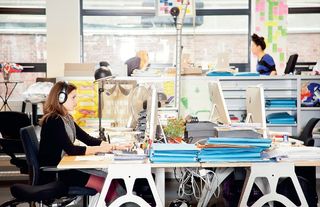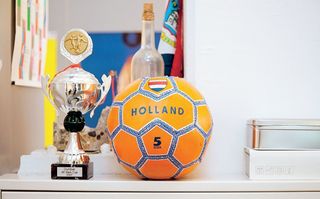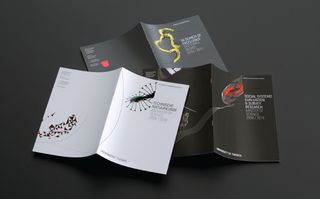Project diary: Electrified typography
When French pop band Husbands wanted a typography-based video for their latest single, they turned to creative duo Cauboyz for help
French pop band Husbands asked creative duo Cauboyz to make a music video for their latest single, ‘Dreams’. The only requirement was that the lyrics were presented with different kinds of typography.
THE DESIGN BRIEF
Bertrand Jamot
Husbands are an exciting new pop band from Marseille in the south of France who Philippe and I have known for quite a while. When they asked us to help out with a music video for their new single ‘Dream’, we absolutely jumped at the chance. Right from the beginning of the project they knew that they wanted the video to be based around the lyrics of the song, which they wanted to be shown using different kinds of typography.
Husbands came to us because one of the band members was familiar with a similar project that we had worked on previously. There was no more to the brief than the typography angle: they trusted us to come up with a good solution for them and gave us no more input or feedback until we delivered the final video to them three weeks later.
Philippe and I spent a couple of days brainstorming different ideas. We knew from the song’s title, ‘Dream’, that we wanted to use a dark background with illuminated type, and we also knew that we had to follow the lyrics. By breaking them up into different lines or parts of lines and then illuminating them we believed that we could create a very watchable video – but we didn’t want the whole thing to be created digitally.

Our approach at Cauboyz has always been centred around the idea of ‘doing it yourself’. We believe that creating real objects in the analogue world can be far more effective than trying to reproduce them digitally. Plus, it’s a lot more fun being outside creating quirky objects than sitting all day long behind a desk. So that’s why we hit upon the idea of using lightboxes, which could then be switched on and off at the same time as the lyrics were being sung in the song. All we had to do next was work out how to make it happen.
WORK IN PROGRESS
Philippe Tytgat
Our original plan for lighting up the lyrics was to use vintage neon signs, but we quickly realised that this was going to be impossible. Instead, we decided to build the lightboxes ourselves, and make them different sizes and shapes to reflect the typography styles we wanted to use.

We created the letterforms in Illustrator and then had them printed and laser-cut onto sticker sheets so that we could use them on the lightboxes we were going to build. We tried and tested lots of different ways to get the effect we wanted – using soft lighting behind the letterforms – and eventually discovered that polystyrene was the most effective material to use, giving us the best results.
We made each box out of cardboard, cutting off one face and replacing it with a thin sheet of polystyrene. We then attached the letterforms to the polystyrene and illuminated them using a lightbulb that we placed at the back of the box. Fortunately, when we finally tested different exposures against a dark background all we could see were the letterforms – not the boxes – just as we had hoped.

However, the next stage of the project was the worst part. We quickly understood that we were going to have to wire each light switch and each lightbulb separately, and trigger each one individually in time to the different words appearing throughout the song, but our electrical knowledge was limited to some long-forgotten lessons at school. After some research on Google, we eventually managed to figure it out and, once we were wired up, Bertrand and I took on the task of switching the lights on and off as we filmed them. It really was as simple as that.
CONCLUSION
Bertrand Jamot
As I mentioned at the beginning, one of our main ambitions is to always try to do things for ourselves, rather than relying on computers, and I think we definitely succeeded with this music video for Husbands. It was certainly one of the most enjoyable projects that we have done: the band gave us complete creative freedom, we had a lot of fun building the set and the reaction to the video since then has been really positive.
Everyone who sees it seems to appreciate the fact that it’s all been done for real, rather than using digital effects and we’re really proud of what we’ve achieved. It’s been viewed over 100,000 times on Vimeo already, which has been pretty gratifying for us too.

THREE LESSONS WE LEARNED
Every project has a learning curve, but some lessons here were more painful than others
1: Doing it yourself is more fun
Something we’ve always believed in, and this project confirmed our belief. By not relying on digital effects we were able to create something unique – and we had a lot of fun while we were doing it.
Get the Creative Bloq Newsletter
Daily design news, reviews, how-tos and more, as picked by the editors.
2: Keep trying new solutions
Because we decided to create physical objects rather than virtual equivalents, we had to do a lot of testing to get the results that we wanted. However, our experiments were worth it.
3: Don’t touch live wires
We rediscovered our respect for electricity after noticing – far too late in some cases – that you should always pull the plug before you touch electrical cables.
Discover 20 must-see examples of kinetic typography at Creative Bloq.

Thank you for reading 5 articles this month* Join now for unlimited access
Enjoy your first month for just £1 / $1 / €1
*Read 5 free articles per month without a subscription

Join now for unlimited access
Try first month for just £1 / $1 / €1
The Creative Bloq team is made up of a group of design fans, and has changed and evolved since Creative Bloq began back in 2012. The current website team consists of eight full-time members of staff: Editor Georgia Coggan, Deputy Editor Rosie Hilder, Ecommerce Editor Beren Neale, Senior News Editor Daniel Piper, Editor, Digital Art and 3D Ian Dean, Tech Reviews Editor Erlingur Einarsson and Ecommerce Writer Beth Nicholls and Staff Writer Natalie Fear, as well as a roster of freelancers from around the world. The 3D World and ImagineFX magazine teams also pitch in, ensuring that content from 3D World and ImagineFX is represented on Creative Bloq.
